| David Hughes  AKA David Edward Hughes AKA David Edward Hughes
Born: 16-May-1831
Birthplace: London, England
Died: 22-Jan-1900
Location of death: London, England
Cause of death: unspecified
Gender: Male
Race or Ethnicity: White
Occupation: Inventor, Physicist Nationality: England
Executive summary: Inventor of the microphone Anglo-American electrical inventor, born on the 16th of May 1831 in London, but the earlier part of his life was spent in America, to where his parents emigrated when he was about seven years old. In 1850 he became professor of music at the Female Academy of Bardstown, Kentucky, and soon afterwards his attainments in physical science procured his appointment as teacher of natural philosophy at the same place.
His professorial career, however, was brief, for in 1854 he removed to Louisville to supervise the manufacture of the type-printing telegraph instrument which he had been thinking out for some time, and which was destined to make both his name and his fortune. The patent for this machine was taken out in the United States in 1855, and its success was immediate. After seeing it well established on one side of the Atlantic, Hughes in 1857 brought it over to his native country, where, however, the telegraph companies did not receive it with any favor. Two or three years afterwards he introduced it to the notice of the French Government, who, after submitting it to severe tests, ultimately adopted it, and in the succeeding ten years it came into extensive use all over Europe, gaining for its inventor numerous honors and prizes.
In the development of telephony also Hughes had an important share, and the telephone has attained its present perfection largely as a result of his investigations. The carbon transmitters which in various forms are in almost universal use are modifications of a simple device which he termed a microphone, and which consists essentially of two pieces of carbon in loose contact one with the other. The arrangement constitutes a variable electrical resistance of the most delicate character; if it is included in an electric circuit with a battery and subjected to the influence of sonorous vibrations, its resistance varies in such a way as to produce an undulatory current which affords an exact representation of the sound waves as to height, length and form. These results were published in 1878, but Hughes did much more work on the properties of such microphonic joints, of which he said nothing until many years afterwards. When towards the end of 1879 he found that they were also sensitive to "sudden electric impulses, whether given out to the atmosphere through the extra current from a coil or from a frictional machine", he in fact discovered the phenomena on which depends the action of the so-called "coherers" used in wireless telegraphy.
But he went further and practiced wireless telegraphy himself, surmising, moreover, that the agency he was employing consisted of true electric waves. Setting some source of the "sudden electric impulses" referred to above into operation in his house, he walked along the street carrying a telephone in circuit with a small battery and one of these microphonic joints, and found that the sounds remained audible in the telephone until he had traversed a distance of 500 yards. This experiment he showed to several English men of science, among others to George Gabriel Stokes, to whom he broached the theory that the results were due to electric waves. That physicist, however, was not disposed to accept this explanation, considering that a sufficient one could be found in well-known electromagnetic induction effects, and Hughes was so discouraged at that high authority taking this view of the matter that he resolved to publish no account of his inquiry until further experiments had enabled him to prove the correctness of his own theory.
These experiments were still in progress when Heinrich Hertz settled the question by his researches on electric waves in 1887-89. Hughes, who is also known for his invention of the induction balance and for his contributions to the theory of magnetism, died in London on the 22nd of January 1900. As an investigator he was remarkable for the simplicity of the apparatus which served his purposes, domestic articles like jam-pots, pins, etc., forming a large part of the equipment of his laboratory. His manner of life, too, was simple and frugal in the extreme. He amassed a large fortune, which, with the exception of some bequests to the Royal Society, the Paris Academy of Sciences, the Institution of Electrical Engineers, and the Paris Socité Internationale des Électriciens, for the establishment of scholarships and prizes in physical science, was left to four London hospitals, subject only to certain life annuities.
Institution of Engineering and Technology
Requires Flash 7+ and Javascript.
Do you know something we don't?
Submit a correction or make a comment about this profile
Copyright ©2019 Soylent Communications
|